Rajendra Pandey: Involvement of mental and emotional levels in yoga is more important than physical
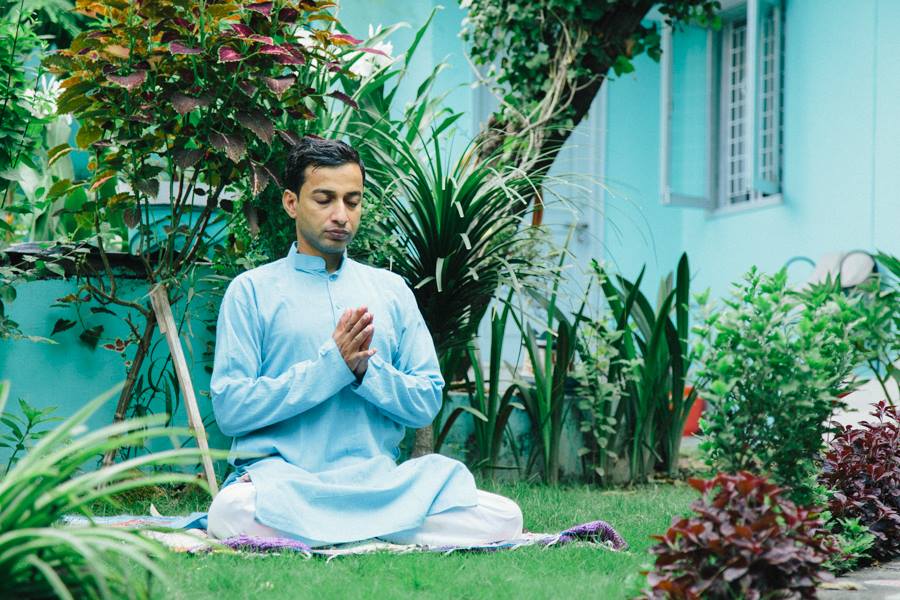
Rajendra Pandey is a teacher of traditional hatha yoga in Rishikesh. This teacher is not extremely well-known in Rishikesh, as he seems not to be very interested in self-promotion. He has a small yoga center in a quiet place in Tapovan with a yoga hall that can fit 10-12 students. Rajendra Ji seems quite content with the smaller amount of students as this allows him to get to know each student closer and make yoga experience more personal. We believe that you need to meet this teacher as he seemed to us an authentic representation of a yogi: genuine, sincere, modest, content with what is, focused more on practice than on business expansion. Below is the transcript of our interview with him.
Rajendra Ji, can you tell us how your journey in yoga started?
It’s difficult to say how it started. Long back. My family is a traditional Brahmin family. So, rituals, chanting, prayer, meditation, all this is a part of the family activity. So I grew up in that kind of environment. But we didn’t practice exercise oriented yoga. So we just did chanting, prayer, kirtan. And in 1995 or 1996, I attended a 1-year course on yoga in Parmarth Niketan Yoga and Naturopathy College. That course I joined just to have an idea about yoga in a physical way and to know more about its roots and its connectivity. So that course changed my way of moving in yoga. I did that course just as a hobby, like many tourists who come to India, and they just want to try something stretching and opening, but I think that’s my destiny that helped me.
I believe in that destiny, because I did my course for 1 year, and luckily I got an invitation from Yoga Niketan ashram, which is one of the auspicious places to practice yoga. The teacher (of Yoga Niketan ashram) was going on a vacation, so he wanted someone to fill the classes. So he approached our principal, and our principal recommended me because I was the person who was able to speak English at a time. So, he recommended my name, and I was invited to teach in Yoga Niketan. So that’s how it started, and my stay in Yoga Niketan was for a half-year, teaching, learning, practicing with Swamiji and other scholars there. And then I was studying sideways on my management and other studies because I was not sure that this (yoga) is my career. I never thought. It just was like a hobby of teaching. At that time yoga was (not popular), in 1996, there were just four or five yoga centers: teaching, practicing, daytime is free time, going out and eating with people, and then going home back. But then I finished my study and then I applied for a job, and in my resume it was written that I was teaching yoga. So I applied for a job in a luxury hotel-spa, and they said: "OK, we would like to take the interview, but for yoga training". So they took an interview with me, and I passed, and they said: “Would you like to teach yoga?” I said, OK, because that’s a big hotel, so it started like that. I taught yoga there for 2 and half years, from there I got a chance to go overseas, I went to Bermuda islands teaching there, so this way my teaching started. I did not know when I became a teacher. From hobby classes to become a teacher. Later on, I studied and I did my master in yoga philosophy, so it was this way. So I think it’s my destiny and with a God’s grace, I became a teacher.
And what for you is the purpose of yoga practice?
Purpose of yoga practice? It’s important that it helps me to be healthy and happy, and also share the skills with other people, society, to stay healthy and happy, and helping them to find their destiny, to find their motive to be a happy person in their life. So that is what yoga helps me in and what I’m passing to my students.
What is your personal practice? Do you have a practice that you try to follow daily?
Not on daily basis, on weekly basis, we do our self-practice, where I practice by myself, maybe 45 minutes, do some asana - a limited number of asana, some pranayama, and meditation.
So you do it once a week? You say weekly basis.
No, twice a week.
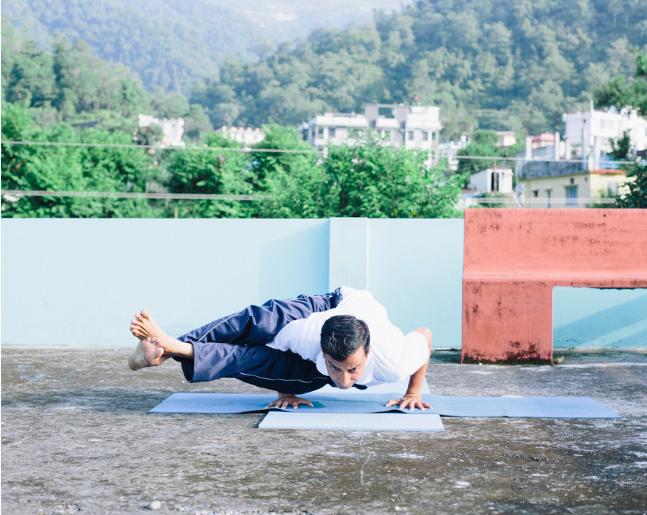
And if a person came to you and said: “Rajendra Ji, I have only 15 minutes for practice every day”. What could they do? What is the most important?
Seeing the condition of a person, then we can suggest something. It is not something ready-made that you go in fifteen minutes and you make instant noodles or something. It is something which is a very personal thing. So a person comes to India and they have a very busy schedule, if they can understand some basic practice - how to bend, how to stretch, how to open, how to breathe, then they can continue back home.
So we can recommend them to start with some loosening practices, some joint opening practices, and some kind of movement which involves some forward bending, some back bending, some rotation, some side stretching - covering the spinal health. And they can go for further things like Sun Salutations.
But it all depends on how much time and how health condition allows, then we can say something.
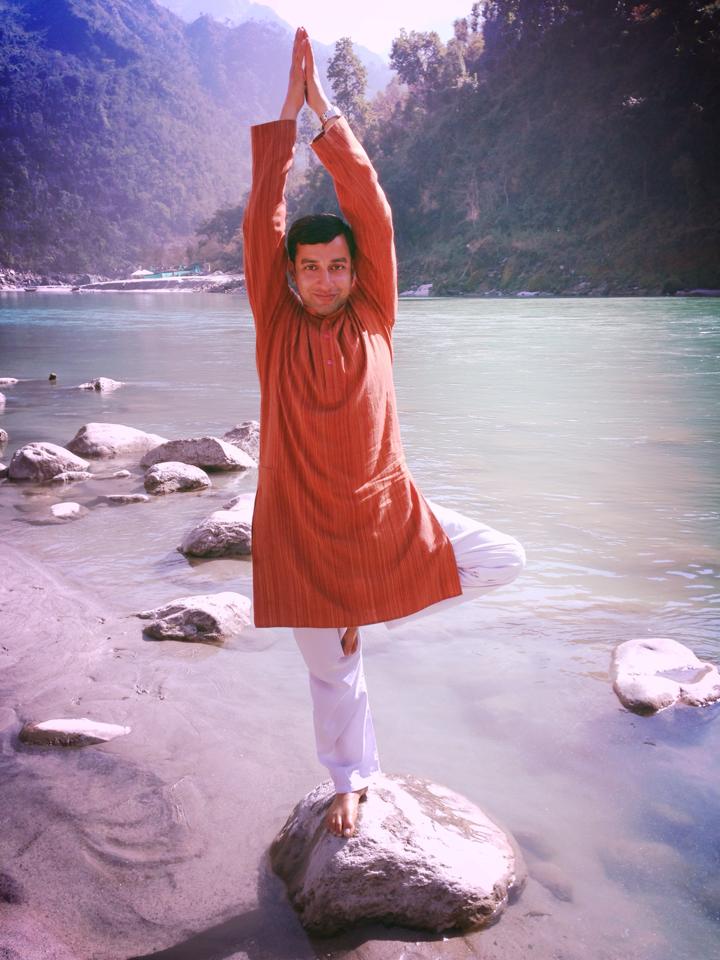 Have you had any injuries connected to your yoga practice?
Have you had any injuries connected to your yoga practice?
Injuries? So far no. Injuries happen when you try to achieve something in a short period.
Did you see anyone coming to you with injuries or having injuries?
Yes. Some students come here. Sometimes it is lack of understanding of the body, the anatomy. Sometimes they want to reach a position very fast. They force, they push the body. My basic understanding is that if you follow your breathing, you will not get injured in yoga. Breathing helps you to know what is your limitation. If you are going beyond your limitation, there are chances that you are not practicing yoga, you just physically stretching your body.
So, you need to follow your breathing in what way? If the breathing stops, that means you have done too much?
No, not stops. When the breathing becomes uneven. When breathing becomes very fast, it means that you’re forcing your body, you are not coordinating with breathing.
So generally yoga is like coordination of your breathing with body movement. You’re being aware with the consciousness that I’m lifting my hands, so my breathing is involved in it, my movement is involved in it, so it is a coordination of breathing and body movement, plus the consciousness. Means, your attentiveness. So when we miss this thing due to over-forcing, due to aggression, due to forceful pushing, then the breathing starts to suffer. It becomes shallow, it becomes faster, sometimes it stops. Like when you push yourself, breathing gets stopped. Which indicates that you’re physically exercising.
As a teacher, how do you approach a challenge of drop-in classes of people coming from all different walks of life, with different bodies, different experiences, different age? And how do we prescribe a certain set of asanas for the class to such a diverse number of people with different bodies and needs? How can we do it in a safe way?
It’s very difficult to satisfy everybody. Sometimes in our classes, it happens that some person practices for 5, 6, 7 years, and some person has their very first class. How to justify this thing? So we say, practice as far as your body permits you. Means, if you’re a beginner student or if you’re trying to explore your body, understand your body limitation. That today I can only bend this much. So you should not force your head or your leg to come too much closer.
At the same time, we are requesting a person who already has practiced, that you should also maintain the posture, but try to think about a different aspect of yoga. Not only physically stretching, look at other aspects: how are your emotions going now? What kind of feeling is coming in your body? What kind of thoughts are coming to your mind? And you’re holding the posture. When one person is struggling to reach there, so this limitation is there, so fist they need to overcome their body limitations. But another person who is already flexible, now your challenge is to observe you, to observe your thoughts, observe your emotion at that point.
So that’s why we are just trying to fix (the attention). And there are certain asanas, certain motions which are applicable to everybody. Like sukshma vyayama exercises, some forward and back bending, some side stretches. There are certain common asanas which we can teach to everyone. Intensity will be different. Some person can stay there for two breaths, one breath, some person can stay there for seven - ten breaths. Depending on that. So in that way, we can make some balance.
What is your approach to headstand? We ask this question to all the teachers because there’s a discrepancy between their opinions. Some teachers think that it is not good for the beginners, while others think that it is very good. What is your position?
It is good. Only the way how you receive (the instruction) on this asana plays a role. With enough preparation, with enough anatomical understanding, you can do this asana. So basically, headstand is not actually a headstand, it is basically your arms and shoulders which hold your body weight. If you teach them before some asanas which strengthen their shoulders, which strengthen their arms, then, of course, why not? You can do it. But there are certain contraindications, which are for people who are suffering from eye disease, some chronic eye problem or cervical problem, of course, they have to take a break with this asana. Otherwise, it is considered a king of asana. So not just anatomically, but it also influences your psychology. It goes on your mental level also.
So you have to see the other aspect of that asana, how it changes your way of thinking. It affects your endocrine glands, pituitary gland, influences them.
So it is one important asana, the only thing is that maybe because of wrong practice, maybe because of some idea that it hurts the neck or some other reason it is not practiced. But then the process should be rectified. Things that are mentioned in scriptures are not wrong. We cannot say this is wrong. The only thing is that our preparation is not right, our ability is not right, but we cannot neglect or we cannot refuse it. It is a time-tested process. People are doing it for a long time.
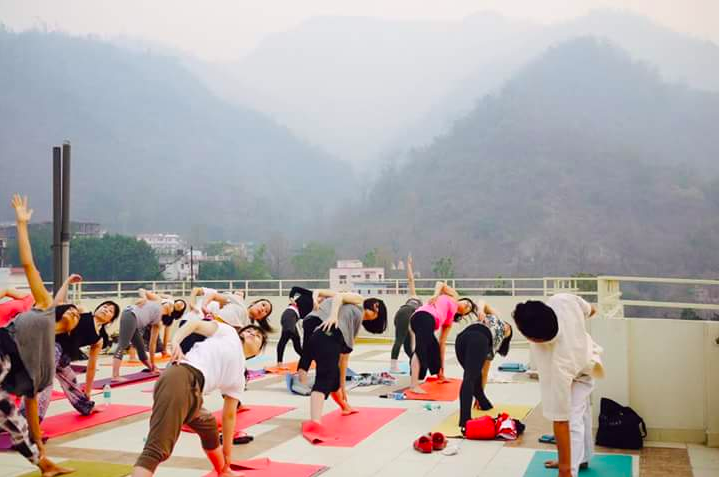
And what do you think about adjusting students in their positions? There are different ways of adjusting, what is your approach to that?
Adjusting is an important aspect of yoga. Some people like it, some don’t. So first, you have to be comfortable with the student, knowing that adjusting will help them. But again, the physical adjustment is secondary, first mental adjustment. They should be able to experience the yoga and understand their limitations. Once they understand their limitations, then some teacher can help them with a better way to do that posture.
Otherwise, if you just try to adjust the body and the mind is not connected, it becomes like a robotic movement. Just mechanical. Involvement of their awareness is most important. So they have to find some way, find the posture which helps them to ground the body.
They have to see how the body can be helped - with the help of the wall, the help of a teacher, if they are experiencing (difficulties), it is good for them. But we have some students who don’t go for that thing. They say: “I respect my body. I just go as far as I’m doing”. So for them, it is not on the physical level, they are just meditating while doing the motion. Of course, if they go too wrong, then we can say, otherwise, there’s no harm. So basically that is your awareness of movement. So adjustment is important, but it is not a pre-condition for learning yoga.
Because this modification is a very new thing. If you see some books of Shivananda school of yoga, if you see some of his postures and you compare to today’s (standards), you can say that the spine is not aligned. But you cannot challenge that he’s not a good yoga teacher. This is something which is a new development in yoga from that anatomical point of view. But the main thing was your power, that feeling with yoga. That is most important, and then mechanically doing something, and fixing your body and finding some alignment. So your involvement of mental and emotional levels is more important than physical.
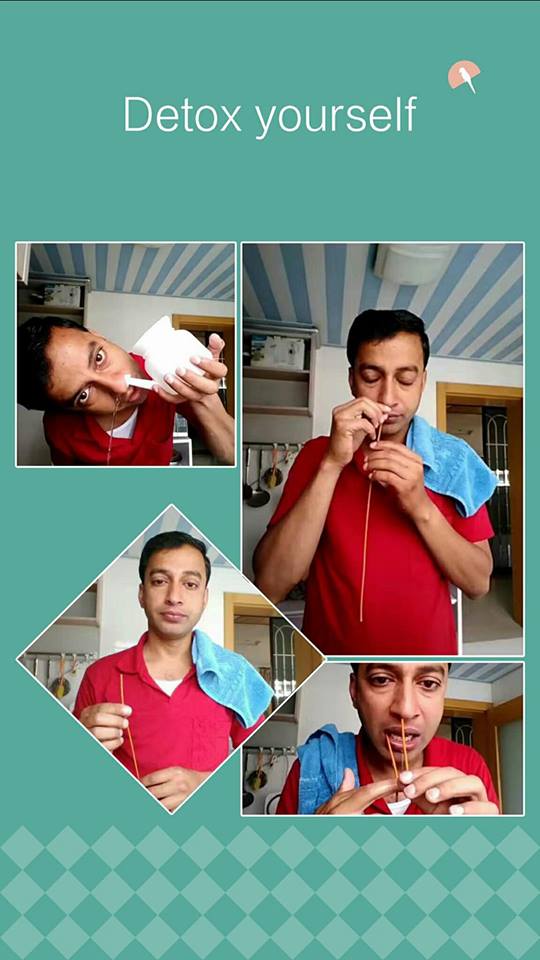 Tell us please, do you do shatkarmas with your students. How important are they?
Tell us please, do you do shatkarmas with your students. How important are they?
Very important. Shatkarmas prepare the ground. Shatkarmas, especially neti and vaman, help in detoxification, taking excess toxins from the body and preparing a ground for practicing asanas. Without shatkarma, you can do yoga practice, but once you go for a course, once you try to adopt yoga as a program for your changing, then, of course, there is a use of shatkarma. But if you’re just a walk-in student, you just come and want to see what yoga is for you, then only (we practice) the physical posture. But once it is like a sadhana, a training for achieving something, purification is important. So hatha yoga starts with kriya. So, first is cleansing, then asana in hatha yoga.
Can a yogi drink coffee?
Yogi can drink coffee, yes, why not?
Well, there is sometimes this opinion that coffee is a stimulant brought from outside. According to this viewpoint, we want to stimulate ourselves and not be dependent on outside substance.
Everything that is naturally available, people can take it. The only thing is the addiction, the dependency on it. So coffee, tea, you can take it, the only thing is that what is the purpose of your learning yoga? If you want to live a life with family, in a social surrounding, of course, this is a common drink in many countries. If your purpose is to become like a monk, saint, holy person, then, of course, you have to avoid those things which are stimulating you, like onion, garlic, too much food which is laxative in nature, it’s not recommended. If your purpose is not that, and you try to stay in a moderation, you can take it.
Do you have any advice for people who come to Rishikesh for the first time and they don’t know what to do, they can be overwhelmed?
Actually, sometimes it happens that people are coming with an image of Rishikesh as a holy city or something like that and sometimes it’s broken down (the image), especially when they arrive at the airport and they see many people, crowds, such things. They should expect that India is a country with lots of population, and it’s still developing, and a lot of things are there which is not in place. Slowly, it’s taking time, be ready for that kind of thing.
First, you cannot expect the luxury of your home from which country you’re coming, and secondly, be open here. You will find many good teachers, many good people here, but also people who sell yoga, in Rishikesh. So you have to be ready for these things. So keep your eyes open, experiencing and learning with many teachers will help you.
I cannot say particular things here, but it’s different than other places in India. Rishikesh is very different. Once you start living here, you will feel very friendly, but at the first level, you may feel very strange. Small streets and cows, and small vendors, they will want to sell you flowers and such things. So sometimes they don’t understand this western point of view that too much looking into Western people, interfering their privacy can be uncomfortable. But people don’t have bad intentions, only they don’t know the culture of the Western people.
Thank you very much.
You can contact Rajendra Pandey and see where he is teaching at his TopYogis page. If you have practiced with him you can share your experience there.
Find hatha yoga teachers in Rishikesh
Find hatha yoga instructors around the world.
Find yoga teachers in Rishikesh (all styles)
Find yoga schools in Rishikesh.
